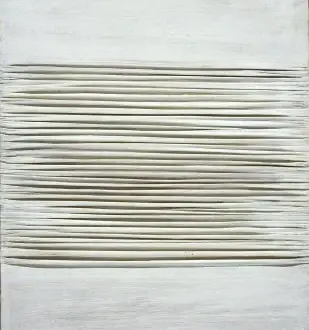Title of Artwork: “Achrome”

Artwork by Piero Manzoni
Year Created 1959
Summary of Achrome
Manzoni Achromes were self-defining works of art that asserted only their own surfaces, surfaces from which all other extraneous detail, artifice, and style had been eliminated.
They were both a response to and an extension of Lucio Fontana’s Spatialist explorations, Alberto Burri’s self-asserting material works, and Yves Klein’s monochromes, in which only their own surfaces were asserted.
Manzoni, who was highly influenced by Freud and Jung’s psychoanalytical literature at the time, referred to his Achromes as “totems,” despite the fact that they were manifestly genuine physical presences that expressed only their own formal and material features.
All About Achrome
The visual plane had always been historically enclosed by an illusory and conceptual space up until these works ultimately and irrevocably broke down. However, they were works of art that began to function as real, unaesthetic concepts in the physical space of the viewer and the environment around them.
The Achrome was consequently a work that heralded the end of the idea of the art-object, and in this view, represented the completion of the anti-material trend inherent in Fontana’s Spatialist aesthetic and also the ‘immateriality’ of Klein’s work.
These previous examples, however, were not enough to establish Manzoni’s ultimate ‘zone’ of freedom and the eventual liberation of art from style. Manzoni emphasised, ‘We cannot see the picture as a space onto which we project our mental scenography.’ ‘It is in this arena of freedom that we hunt for our first visions.’
Absolute images, which can only be regarded for what they are, rather than what they record, explain, or communicate. Piero Manzoni, For the Discovery of a Zone of Images. 1957.)
Although Manzoni advocated for the emancipation of art from style, his unique’styleless’ creations often betray the artist’s own brilliant and unfailing sense of style.
For example, the Achromes of 1957–58 and 1958–59 in this case, are two quite distinct representations of the same autonomous and self-defining, “styleless” concept.
Unlike the other Achrome, which has a kaolin-coated pleat that makes a dramatic line of self-asserting material texture across the centre of a normally flat white canvas, the loose informel-like folds of this one seem to embrace a lush Baroquelike elegance.
Many of Manzoni’s works have the same understated elegance as these two, despite the fact that they have moved away from materiality and hardly any involvement by the artist’s hand, finally transcending the objecthood of art to become merely motions and/or concepts.
All of Manzoni’s work, from the endless linee (lines) to the thumb-printed egg series to the balloons of his own breath to the mass-produced tins of “merda d’artista” (his own shit), was characterised by a cool elegance.
Information Citations
En.wikipedia.org, https://en.wikipedia.org/.
























